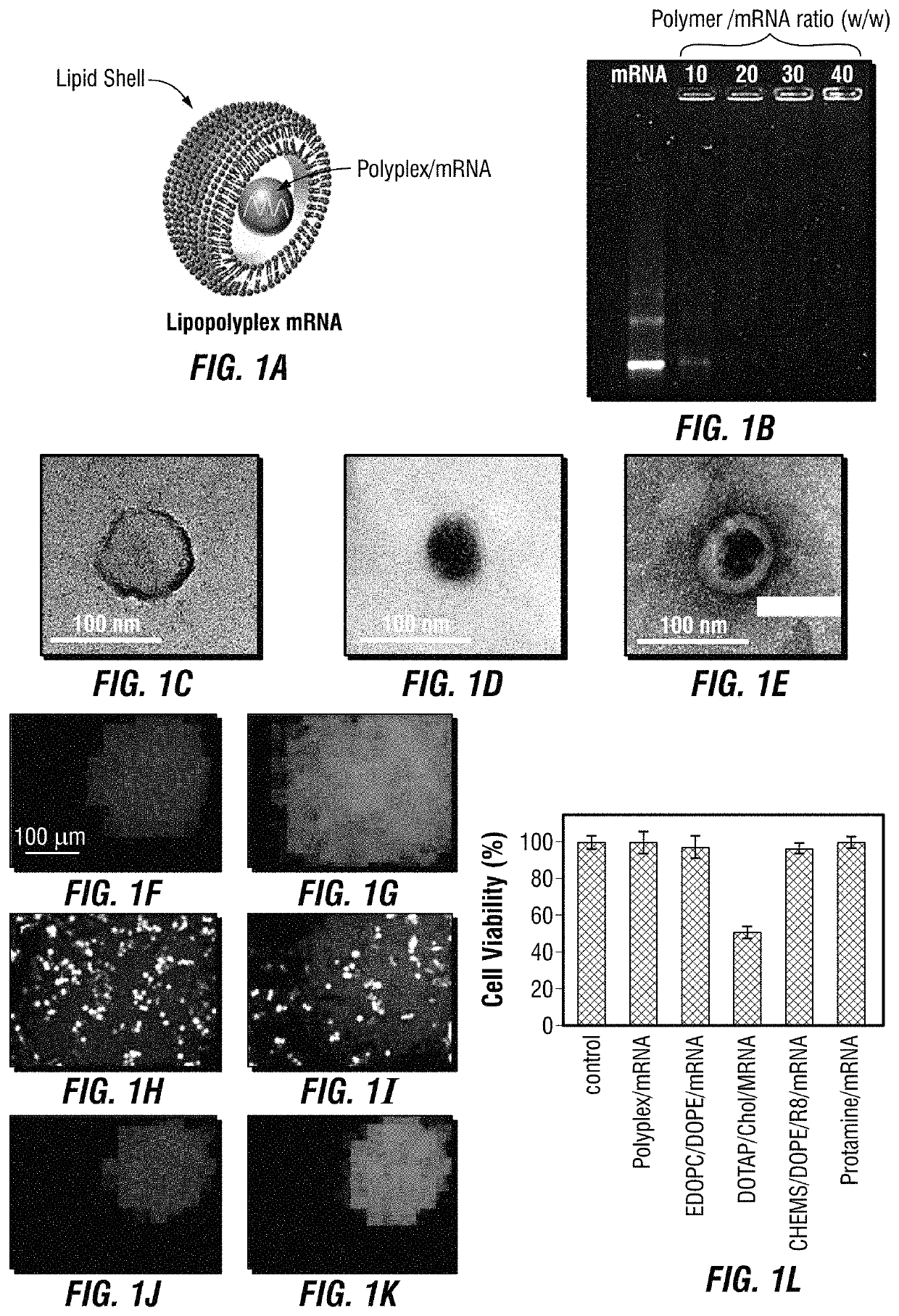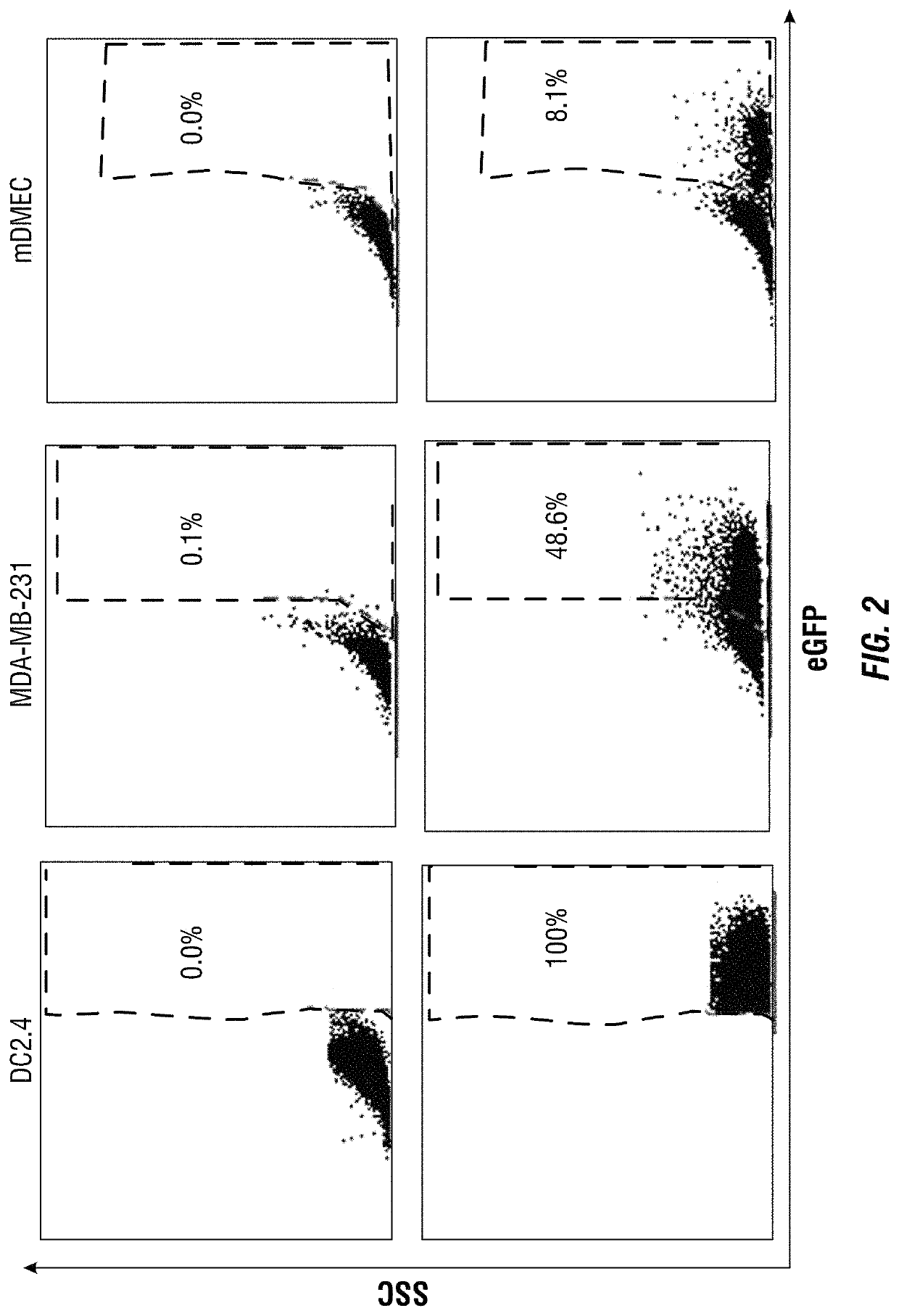Core/shell structure platform for immunotherapy
a core/shell structure and immunotherapy technology, applied in the field of molecular biology and oncology, can solve the problems of uncontrollable genomic integration, low potency of dna vaccines, and inability to mass produce off-the-shelf therapeutic vaccines
- Summary
- Abstract
- Description
- Claims
- Application Information
AI Technical Summary
Benefits of technology
Problems solved by technology
Method used
Image
Examples
example 1
lex Potentiates Anti-Tumoral Immunity of mRNA-Based Vaccines
[0194]In this example, a lipopolyplex mRNA vaccine is described, which consists of a poly-(β-amino ester) polymer mRNA core encapsulated into a 1,2-dioleoyl-sn-glycero-3-ethylphosphocholine / 1,2-dioleoyl-sn-glycero-3-phosphatidyl-ethanolamine / 1,2-distearoyl-sn-glycero-3-phosphoethanolamine-N-[amino(polyethyleneglycol)-2000 (EDOPC / DOPE / DSPE-PEG) lipid shell. This core-shell structured mRNA vaccine enters dendritic cells through macropinocytosis. It displayed intrinsic adjuvant activity by potently stimulating interferon-α and interleukin-12 expression in dendritic cells through Toll-like receptor 7 / 8 signaling. Dendritic cells treated with the mRNA vaccine displayed enhanced antigen presentation capability. Mice bearing lung metastatic B16-OVA tumors expressing the ovalbumin antigen were treated with the lipopolyplex mRNA, and over 90% reduction of tumor nodules was observed. Collectively, this core-shell structure provides a...
example 2
lex Potentiates Anti-Tumoral Immunity of mRNA-Based Vaccines
[0250]FIG. 8A and FIG. 8B show the size distribution of untargeted and targeted mRNA vaccine particles. The targeted mRNA vaccine has mannose on the surface of lipid shell. Since dendritic cells express a mannose receptor and tend to bind to particles with a mannose moiety on surface with a high binding affinity. It was prepared by following the same procedure as untargeted mRNA vaccine. Lipid composition for the shell is 49% EDOPC, 49% DOPE, 1% DSPE-PEG, and 1% DSPE-PEG-mannose. Both untargeted and targeted mRNA vaccine particles are within 40-200 nm range, and medium size of the targeted particles is bigger than the untargeted ones.
[0251]FIG. 12A and FIG. 12B show that dendritic cells take up targeted mRNA vaccine more effectively than untargeted mRNA vaccine. The targeted mRNA vaccine has mannose on the surface of lipid shell. It was prepared by following the same procedure as untargeted mRNA vaccine. Lipid composition f...
example 3
ized Description of the mRNA Vaccine Platform
[0254]FIG. 20 illustrates an overall description of the mRNA vaccine platform disclosed herein. The vaccine is preferably composed of a plurality of hydrophobic “core” structures (each comprising at least one mRNA encoding an antigen of interest), that are comprised within hydrophilic “shell” structures (comprised of a liposomal-bilayer and formulated to effectively encapsulate the core structures therein). The hydrophobic “core” preferably includes a population of negatively-charged mRNA molecules and positively-charged polyplex (e.g., PbAE) or protein (e.g., protamine) molecules, while the hydrophilic “shell” is preferably composed of a combination of lipids and / or phospholipids in a pre-selected and optimized ratio. In certain embodiments, it may be desirable to “functionalize” the surface of the lipid shell by conjugating one or more affinity moieties to it (e.g., sugar moieties such as mannose, binding proteins, or antibodies specifi...
PUM
| Property | Measurement | Unit |
|---|---|---|
| weight percent | aaaaa | aaaaa |
| weight percent | aaaaa | aaaaa |
| weight percent | aaaaa | aaaaa |
Abstract
Description
Claims
Application Information
 Login to View More
Login to View More - R&D
- Intellectual Property
- Life Sciences
- Materials
- Tech Scout
- Unparalleled Data Quality
- Higher Quality Content
- 60% Fewer Hallucinations
Browse by: Latest US Patents, China's latest patents, Technical Efficacy Thesaurus, Application Domain, Technology Topic, Popular Technical Reports.
© 2025 PatSnap. All rights reserved.Legal|Privacy policy|Modern Slavery Act Transparency Statement|Sitemap|About US| Contact US: help@patsnap.com



